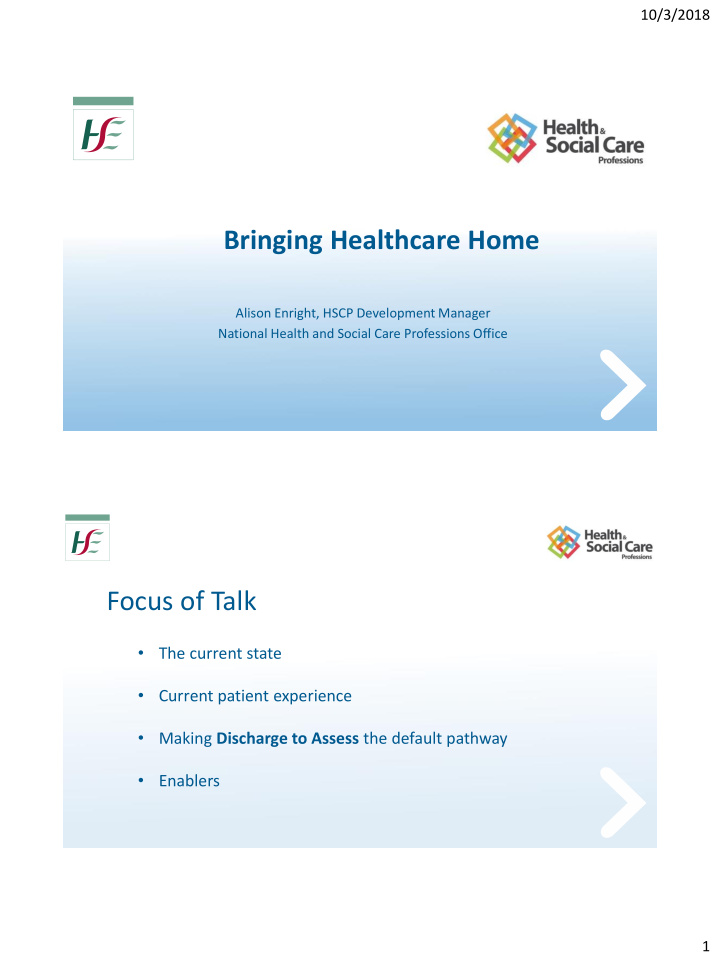



10/3/2018 Bringing Healthcare Home Alison Enright, HSCP Development Manager National Health and Social Care Professions Office Focus of Talk • The current state • Current patient experience • Making Discharge to Assess the default pathway • Enablers 1
10/3/2018 Current State ED Admissions:1000 population by age Population growth 2011-2022 0-16 17-64 65-84 85+ Total Pop 400.0 60 350.0 12.5% of 50 300.0 discharges use 57.3% of bed days 40 250.0 200.0 30 % 150.0 20 100.0 10 50.0 0 0.0 -10 2011 2012 2013 2014 2015 2016 2017 2018 2019 2020 2021 2022 Patrick’s Story (video not available in presentation) 2
10/3/2018 Why Change our System? Need to increase Current model is not Need to enable patient Causing harm patient trust and working choice satisfaction Need to provide safe and timely discharge of Need to improve flow Need to improve patients with complex Need to reduce cost and reduce LOS employee satisfaction needs, with no increase in readmissions No of re- admissions ≥years by Day 7 Jan to June 2015 to 2018 7 day re-admission Rate 18 16 14 Reduction in 7 day 12 re-admissions of 10 29.4% 8 6 7 day emergency re-admissions ≥ 75 years 4 # Discharges 85 82 2 60 0 Day 1 Day 2 Day 3 Day 4 Day 5 Day 6 Day 7 20 16 20 17 20 18 85 82 60 2016 2017 2018 3
10/3/2018 What Smart Hospitals Do • Focus on the admission pathway (early assess and short stay) • Maximise emergency day care (ambulatory emergency care) • Assertively manage frailty and tackle deconditioning • Focus on down-stream flow • Have processes to reduce delays • Focus on simple discharges … case manage and not over assess in hospital • Work as a system – as a team of teams Flipping Discharge Assessment 4
10/3/2018 Discharge to Assess Model: Redesign of the Care Process Where patient are clinically optimised and do not require an acute hospital bed, but may still require funded care services, in the short-term, to be discharged to their own homes or other community settings. Assessment for longer-term care and support needs is then undertaken in the most appropriate setting and at the right time for the person. Discharge to Assess Principles • Home is default pathway – home first ethos • Prompt assessment and rapid access to care • Time limited support service • A service that tries to say yes 5
10/3/2018 The Team…… Access to: OT PT Nurse Multi-task Assistant SLT Dietitian MSW Doctor Pharmacist Discharge to Assess Outcomes Sheffield Headline Outcome: South Warwickshire 37% increase in patients Headline Outcome : discharged on day of 0.5m net long-term costs admission/following day averted in year 1 by reducing conversion to LTC Medway Headline Outcome: Delayed transfer of care rates down 25% in 3 mths, discharging 32 patients per week 6
10/3/2018 Highlights of D2A Test Beaumont Hospital 2016/7 > € 740,000 savings 53 people in their for cost of 1WTE OT own beds for 5 months 70 – 101 years o 96% improved or 81% safely TUG – 49% maintained their 50% of patients did maintained at FIM pre/post Improvement not have any home > 30 days formal HCP in situ intervention 44% cognitively impaired What Our Patients are Saying I had lost my faith in myself, having a fall knocks your confidence, you've given it back to me, I'd recommend you to all my friends. (Patient) I went back to my art class, I was nervous, but I knew I was alright to go, sure I'm probably fitter then I was in year. (Patient) Normally when you leave hospital they forget about you, but this service has been brilliant, you've given me my mother back. (Daughter of patient) She’s a new woman, I was so worried. Now she is back to herself. (Daughter of patient) This is the best help we've had leaving the hospital, you've given him a huge boost to his confidence. (Wife of patient) 7
10/3/2018 Therapist experience 1. Difficult challenging the status quo 2. Time & perseverance required in building trust & openness for effective team work 1. Empowering to design a service which is right for patients 2.Proud to work in partnership on what matters to them 3.Grateful for the opportunity to develop leadership skills Discharge to Assess – Top Tips • Whole system approach • Senior decision-making • Own your competence • Inter-disciplinary working • Shared documentation • Trusted assessor model • Multi-agency meetings • Shared governance • Shared funding 8
10/3/2018 Measuring Performance, Driving Improvement • Re-admission rate – 7, 30, 60, 90 days • % pts, with services in situ, within 48 hrs of DC • % pts awaiting an agreed service in any week • % pts delayed DC who are fit for DC from Medical/HSCP perspectives • Proportion pts DC to LTC without opportunity for short-term recovery • Proportion of pts who return home from transitional care (should be 75%) • Proportion of pts requiring LTC after short-term home-based rehab (should be 25%) • Proportion of pts DC who have no formal supports at 2 wks and 6 wks (should be 40%/66%) (https://ipc.brookes.ac.uk/publications.html ) Embracing Risk and Enabling Choice 9
10/3/2018 Systems Leadership – Comfortable with Chaos Myron’s Maxims • People own what they create • Real change takes place in real work • The people that do the work do the change • Start anywhere but follow it everywhere • Keep connecting the system to itself • The process we use to get to the future determines the future we get 10
Recommend
More recommend